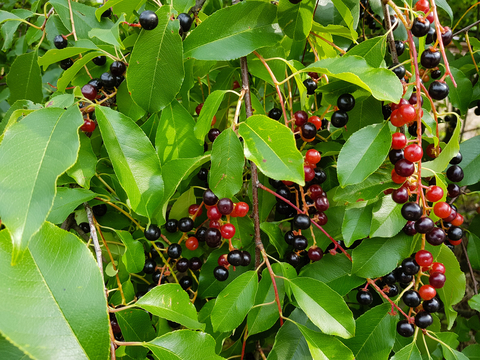Wild Cherry Biological Sources, Morphology, Chemical Constituents, Adulterants and Uses + MCQ (10)
Wild Cherry
Synonyms :-
Virginian Prune, Black Cherry, Virginian Bark, Cortex Pruni.
Biological Source :-
Wild cherry bark is the dried bark of Prunus serotina Ehrhart., belonging to family Rosaceae.

Geographical Source :-
North America generally, especially in Northern and Central States.
Cultivation and Collection :-
This tree grows from 50 to 80 feet high, and 2–4 feet in diameter. The bark is collected in autumn from young branches and stem. In some cases cork and cortex are removed after collection, by peeling. If the bark is peeled it is called rossed bark and if not peeled, it is unrossed barks. It is carefully dried and preserved in airtight containers.
Characteristics :-
Colour : Dark-brown colour
Odour : Mostly very faint; but when slightly moisten it has an odour resembling to that of benzaldehyde (bitter almond like)
Taste : Bitter and astringent
Size : Length = 10 cm; Width = 4 cm; Thickness = 3-4 mm
Shap : Mostly curved or chanelled
Fracture : Short and granular
Inner Surface : Reddish brown and longitudinally striated
Outer Surface : ‘Rossed Bark’ – Rough with pale buff coloured lenticel scars; ‘Unrossed
Bark’—Reddish brown to brownish black, smooth, glassy and exfoliating cork having prominent whitish lenticels.
Chemical Constituents :-
It contains prunasin, a cyanogenetic glycoside. Prunasin is hydrolysed in presence of water by prunase enzyme present in the drug into benzaldehyde, glucose and hydrocyanic acid. It further contains coumarin derivative scopoletin. Starch, resin, tannin, gallic acid, fatty matter, lignin, red colouring matter, salts of calcium, potassium, and iron, also a volatile oil associated with hydrocyanic acid are present.
Uses :-
Astringent tonic, pectoral, sedative and expectorant. It has been used in the treatment of bronchitis of various types. It is valuable in catarrah, whooping cough, and dyspepsia.
Adulterants :-
Areca nut and it’s products available in the market are contaminated and adulterated with toxic chemicals like polycyclic aromatic hydrocarbons and dangerous insecticides such as DDT and BHC isomers in addition to toxic metals.
MCQ
1. Wild Cherry belong to family
A. Liliaceae
B. Solanaceae
C. Combretaceae
D. Rosaceae
2. Which of the following is synonymous of Wild Cherry?
A. Pannax
B. Jethimadh
C. Prune
D. Mulethi
3. Which of the following is not use of Wild Cherry?
A.Sedative
B. Ulceration
C. Dyspepsia
D. Astringent tonic
4. Which of the following is Adulterant of wild Cherry?
A.Virginian Prune
B. Fenugreek
C. Radixrhei
D. Fox glove
5. How many cm height of wild Cherry tree ?
A. 100-110 feet
B. 10-20 feet
C. 20-40 feet
D. 50-80 feet
6. Which of the following is false sentence about Wild cherry ?
A. Wild Cherry has reddish brown colour in Inner side of bark.
B. Wild Cherry has sweet in taste.
C. Wild Cherry has astringent taste.
D. Wild Cherry has short and granule.
7. If wild Cherry bark is peeled it is called
A. Rossed Bark
B. Unrossed Bark
C. A and B
D. None of the above
8. Which of the following type of Glycoside present in Wild Cherry ?
A. Cardiac Glycoside
B. Cyanogenetic Glycoside
C. Iso thio cyanate Glycoside
D. N- Glycoside
9. Which of the following is major chemical constituents of wild Cherry ?
A. Glucose
B. Scopoletin
C. Prunase
D. Prunasin
10.If wild Cherry bark is Unpeeled it is called
A. Rossed Bark
B. Unrossed Bark
C. A and B
D. None of the above
h//Participate in Online FREE GPAT TEST: CLICK HERE
http://Participate in Online FREE Pharmacist TEST: CLICK HERE
http://Participate in Online FREE Drug Inspector TEST: CLICK HERE
http://Participate in CSIR NET JRF Mock Test
https://gpatindia.com/gate-mock-test/
Answer Key
1. D
2. C
3. B
4. A
5. D
6. B
7. A
8. B
9. D
10. B
Reference :-
16 Edition of Trease and Evans Pharmacognosy Text Book ( Pg. No. :- 348)
Phytopharmacological Possibilities of Bird Cherry Prunus padus L. and Prunus serotina L. Species and Their Bioactive Phytochemicals
https://www.ncbi.nlm.nih.gov/pmc/articles/PMC7399899/